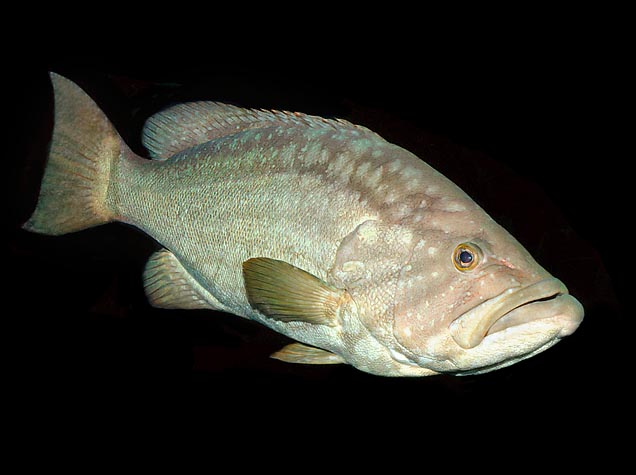Family : Serranidae

Text © Giuseppe Mazza

English translation by Mario Beltramini

The Mottled grouper (Mycteroperca rubra) can be 140 cm long and weigh of 50 kg © Giuseppe Mazza
The name of the genus comes from the Greek “mykter” = nose, and “perke” = perch with reference to the profile of the fish recalling that of the perch.
The name of the species, “rubra”, comes from the Latin “ruber” = red, with reference to the background colour of the fish.
Zoogeography
Its distribution is very ample. Besides the Mediterranean, Black Sea excluded, we find it, after the Gibraltar Strait, along the warm European Portuguese and Spanish coasts, up to the Galicia, and southwards, passed Madeira, the Acores, the Canary and the Cape Verde Islands, along the entire African coast, up to Angola.
Ecology-Habitat
Like almost all groupers, it loves the rocky coasts, but it is less territorial, less tied to a burrow, and we find it often on the sandy bottoms and in the prairies of Posidonias (Posidonia oceanica) usually between the 15 and the 40 m of depth. After some, it might go down even up to 200 m.
Morpho-physiology
The mottled grouper usually reaches the 80 cm, but they have caught a specimen of more than 140 cm and 50 kg.

The patterns are more marked and visible in the young © Giuseppe Mazza
The background colour, reddish, is more intense on the back in the adults. On the sides, especially in the young, some dark strips are noted, more or less continuous, converging towards the operculum, where three wide strips are always well visible. The similar ones, present in the juvenile phase of the Epinephelus costae, are thinner in comparison.
Ethology-Reproductive Biology
The Mycteroperca rubra nourishes mainly of cephalopod molluscs and of young fishes, sparids especially. Little is known about its reproduction, apart the fact that the eggs are pelagic. Also this species displays a protogynous hermaphroditism, with females that, while ageing, tend to transform in males. The vulnerability index of this species is of 46 over 100.
Synonyms
Cerna macrogenis Sassi, 1846; Epinephelus ruber Bloch, 1793; Mycteroperca scirenga Rafinesque, 1810; Serranus armatus Osório, 1893; Serranus emarginatus Valenciennes, 1843; Serranus nebulosus Cocco, 1833; Serranus tinca Cantraine, 1835; Sparus scirenga Rafinesque, 1810.
→ For general information about FISH please click here.
→ For general information about BONY FISH please click here
→ For general information about CARTILAGINOUS FISH please click here.
→ To appreciate the BIODIVERSITY of BONY FISH please click here.
→ To appreciate the BIODIVERSITY of CARTILAGINOUS FISH please click here.
